All our presidents’ flags
A Presidential Standard is a vital symbol of office in most countries around the world. In Sri Lanka, the tradition is said to have begun with President J.R. Jayewardene and continues today under the tenure of President Maithripala Sirisena.

The newest: President Maithripala Sirisena’s flag with black for clarity, says artist
From swearing-in ceremonies to meetings with Heads of State, a Sri Lankan President in office is rarely seen without the accompanying standard (often in the form of a flag) by their side.
The President’s standard, we gather, is indicative of his or her vision for their tenure. Most flags closely resemble the national flag with some basic design tenets such as the four bo leaves and colour schemes running fairly parallel over the course of six presidents.
The Sunday Times attempted to delve deeper into the design aspect and significance of these Presidential Standards, a very personalised custom each President brings into office with him/her.
Our task was made challenging by a surprising lack of information in the media and national knowledge depositories such as the National Archives and the National Library and Documentation Services Board on the subject.
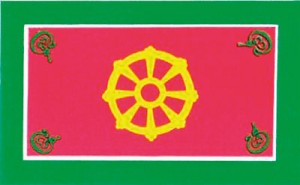
‘Flagblazer’: President J.R. Jayewardene’s Presidential Standard
Persistent inquiry from the Presidential Secretariat Office revealed that the office staff themselves were uninformed with regard to this standard- the general consensus was that each President had a new flag designed for their tenure, and this was used for state events.
From what we did gather, the first official flag was designed for the first Executive President J.R. Jayewardene (1978-89). President Jayewardene’s flag consisted of a brownish green base colour, with a red rectangle superimposed on it within which was a yellow dhamma chakra and four emblems in the corners that spell out ‘jaya’ (victory).
The wheel of dhamma represents justice and the eight-fold path of the Dhamma.
President Ranasinghe Premadasa’s (1989-93) flag takes on a similar colour scheme, with a marked difference in the symbolism used. The flag is bordered by yellow rice leaves with a green bo-leaf in each corner.
In the centre lies a kaleidoscopic lotus flower. President D.B. Wijetunga’s (1993-94) reverts to the original dharma chakra and bo leaves design.
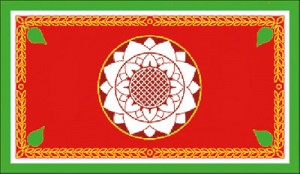
President R. Premadasa: Similar colour scheme
President Chandrika Kumaratunga’s (1994-2005) uses a yellow on maroon colour scheme, once again with four bo leaves and lotus flower.
While the designers behind the older flags are not known, we did find the designers behind the two most recent ones.
Batik industry veteran Buddhi Keerthisena was asked to design President Mahinda Rajapaksa’s (2005-2015) flag when he first took office in 2005.
Pressed for time (the designer had 36 hours notice before the swearing-in ceremony) Keerthisena designed a quick solution of a flag-“but I was not satisfied with it,” he remembers. “So I asked the President for some time to design a more meaningful flag.”
The final version of the flag has a clear batik motif. Keerthisena uses flowered chains around the border to represent the unity of the people of Sri Lanka, a flowered pattern in the middle, green and orange flowers in the outer corners for minority representation and bo-leaves to symbolise Buddhism.
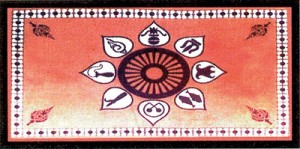
President D.B. Wijetunga: Back to original dharma chakra and bo leaves
Keerthisena is happy with his final result, which was used for almost a decade as the country transitioned from turbulent to more peaceful times.
The newest flag is incumbent President Maithripala Sirisena’s. Markedly different to its predecessors, with a sharper-edged design and sombre-shaded flower in the middle, it is by young designer Chamil Harshana Edirisinghe from the Kandy district, its design perhaps also indicative of the drastic changes the country and our conceptions of nationality have undergone over the last few years.
Thirty-four-year-old Edirisinghe is a visiting lecturer at the University of Visual and Performing Arts.
He was contacted via the university and received only a few guidelines – the flag must draw some design elements from its predecessors but also represent a strong sense of the new President’s vision.
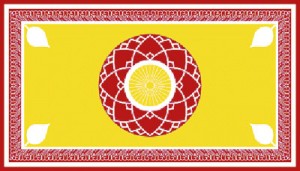
President Chandrika Kumaratunga : Lotus flower and bo leaves
He drew his inspiration from the Polonnaruwa era architecture-“I felt it was appropriate given President Sirisena’s roots,” he explains. The background is predominantly maroon with a white border and bo-leaves in each corner as before.
The lotus in the middle is drawn from the Lotus Pond in Polonnaruwa and the white border lining the flag uses elements of moonstones from the same era (see box for breakdown of features and symbolism).
Edirisinghe has daringly included the colour black in the flag- partly to refine his design but also to symbolize clarity; “I know that it’s very different to other flags because black is traditionally seen as an unlucky colour,” he says “but here I’m trying to say that it’s not always a bad thing. Clarity is important for a Head of State.”
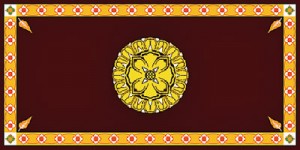
President Mahinda Rajapaksa: Batik motif
| Colours and shapes: What they signifyWhite circle in the middle: embodies perfection, fairness, humanity, impartiality and honesty White ring: protects the above (five) qualities White circle on a dark brown background: compassion even in times of trouble and strife. Maroon background: symbolises the Sri Lankan nation, national unity, prosperity and pride The (square) border: national security The four bo leaves: protection provided by Dhamma and the four qualities of Metta: loving kindness, Karuna: compassion, Mudita: sympathetic joy; Upekkha: equanimity The lotus: the awakening, development, pride and purity of the nation The yellow petals: abiding by religion (Dhamma) and good governance Pink, orange and red petals: radiate propriety, gradual growth, and royal splendour. Also embody the main religions The white outlines between petals: similarity; acceptance of different creeds and philosophies Dark line around the lotus: clarity |


